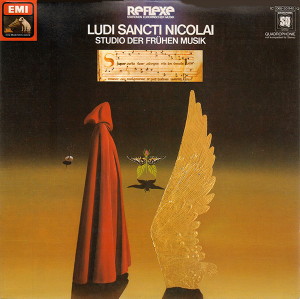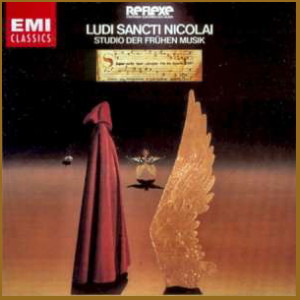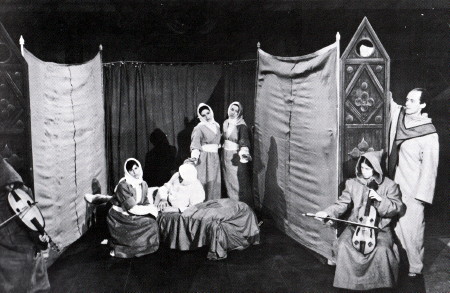 |
1 LP -
1C 065-30 940 Q - (p) 1978
|

|
| 1 CD - 8
26509 2 - (c) 2000 |
|
| LUDI SANCTI
NICOLAI (Die Wunder des heiligen
Nikolaus) |
|
|
|
|
|
| TRES FILIAE
(Die drei Töchter) |
28' 50" |
|
| - St. Nikolaus: Christian
Tréguier |
|
|
| - Pater: Jean
Marie Gouelou |
|
|
| - Filiae: Barbara
Thornton, Esther Lamandier,
Candice Smith |
|
|
| -
Generi: Rachid Safir, Ben Bagby,
Richard Levitt |
|
|
|
|
|
| ICONA
SANCTI NICOLAI (Die Ikone des
Heiligen Nikolaus) |
21'
37"
|
|
| - St. Nikolaus: Christian
Tréguier |
|
|
| - Judeus: Ben
Bagby |
|
|
| - Fures: Richard
Levitt, Rachid Safir, Jean Marie
Gouelou |
|
|
|
|
|
| STUDIO DER FRÜHEN
MUSIK (an der Schola Cantorum
Basiliensis) |
|
-
Dana Maiben, Sigrid Lee, Alice
Robbins, Sterling Jones, Instrumentalisten
|
|
| in
Zusammenarbeit mit dem |
|
| ENSEMBLE VOCALE
GUILLAUME DUFAY |
|
| Thomas
Binkley, Musikalische
Einrichtung |
|
| Andrea
von Ramm, Gesamtleitung |
|
|
|
|
|
Luogo
e data di registrazione |
|
Amsterdam,
(Olanda) - 13 giugno 1977 |
|
|
Registrazione: live /
studio |
|
studio |
|
|
Producer / Engineer |
|
Gerd
Berg / Johann-Nikolaus Matthes
|
|
|
Prima Edizione LP |
|
EMI
Electrola "Reflexe" - 1C 065-30
940 Q - (1 lp) - durata 50' 37" -
(p) 1978 - Analogico
(Quadraphonic) |
|
|
Prima Edizione CD |
|
EMI
"Classics" - 8 26509 2 - (1 cd) -
durata 50' 37" - (c) 2000 - ADD |
|
|
Note |
|
- |
|
|
|
|
|
 LUDI SANCTI
NICOLAI LUDI SANCTI
NICOLAI
The
Miracles of Sanct
Nicolaus
St.
Nicholas, according to Roman
liturgy, was born in the
fourth century in the city of
Patara, province of Lycia
(Turkey). His well-to-do
parents died when he was a
boy, and the young Nicholas
distributed his inherited
wealth to the poor. He wan a
pious man, who fasted on
Wednesdays and Fridays
throughout his life. And he
was a kind man, and this
quality above all others
secured him a place in the
hearts of Medieval Christians,
in both East and West. It
happened that Nicholas went to
the city of Myra, capital of
Lycia, just as the Bishop
died. The provincial Bishops
had gathered there to elect a
new Bishop and they were told
by a revelation that they
should select a man who the
next day would be the first to
enter the church, whose name
would be Nicholas. Thus
Nicholas became Bishop to
Myra. Contrary to the edicts
of Dioclesian and Maximian,
Nicholas preached the
Christian faith and was
imprisoned until Constantine
was made emperor. Nicholas
died after returning to Myra
from the Council of Nicea,
where he had condemned the
Arian heresy.
The
ninth century Archimandrite
account of his life formed the
basis of the Greek
biographies, while in that
same century it was Johannes
Diaconus of Naples who wrote
the basic Latin vita,
which was included in the
encyclopaedia of Vincent of
Beauvais as well as Jacobus de
Voragine in his Legenda
Aurea. In the tenth and
eleven centuries the cult of
Nicholas flourished. New vitas
were written, adding
substantially to the number of
miracles. Numerous churches
and abbeys were dedicated to
him, and there appeared hymns
and a complete office with
music, which had wide
circulation in Normandy (this
office, from St.
Maur-la-Fossés is similar to
both Worcester and Sarum use).
(The extensive iconography
related to this saint -
hundreds of citations - has
been collected by Karl Maisen,
Nikolauscult...,
1931.). The special
relationship between the
Normans and the Mediterranean
world played a rol in the
popularity of St. Nicholas. It
was Norman sailors who stole
the relics of Nicholas from
Myra and brought them to Bari,
which they had conquered in
1071. From here a finger of
Nicholas made its Way
mysteriously to a chapel on
the Meurthe, which then became
an important pilgrim goal, and
which grew into one of the
larger medieval cities in
Lorrain. Saint
Nicholas-du-port. Four
miracles of Sr. Nicholas were
adopted for presentation as
plays during the Middle Ages.
Two of them have been recorded
here:
Tres
Filiae
A man of noble birth has lost
his wealth and cannot provide
a dowry for his three
daughters. The eldest daughter
decides to sell herself as a
prostitute in order to provide
money, but just as she
suggests this, a bag of gold
is tossed through the window,
and a genor appears to
claim the hand of that
daughter. This repeats for the
remaining two daughters, and
as the last bag of gold comes
through the window, the father
goes into the street and
discovers it was St. Nicholas
who threw the gold. (This is
the only authenticated legend,
appearing in the earliest
sources which identify the
nobleman as a neighbour of
Nicholas.)
Iconia
Sancti Nicolai
A Jew, having heard of the
reputation of St. Nicholas,
employs an icon of St.
Nicholas to guard and protect
his house and possessions as
he goes abroad. Three robbers
enter the house and steal the
treasure. On returning, the
Jew discovers his loss, flies
into a rage directed at the
icon and promises to burn the
icon the next day. Nicholas
appears before the robbers and
gives them the choice of
returning the treasure or
facing civil justice. They
return the treasure while the
Jew is sleeping, and thus the
reputation of Nicholas remains
intact.
The
legend of Tres Filiae
is mentioned in all the vitas
(with variations) and is
included in the antiphons for
the office of St. Nicholas. Iconia
is one of the added miracles
from the 11th century,
inspired by a Saracen invasion
of Calabria. During the
pillaging, it seems that one
of the invaders found an icon
and carried it off. On hearing
of the power of Sr Nicholas,
he left the icon to guard his
possessions. Hilarius, a pupil
of Abélard, also wrote a play
on this legend (employing
French refrains) while the
most extensive treatment is
that of Jean Bodel, Jeu de
de Nicolas, written
entirely in the vernacular.
A twelfth century manuscript
at the monastery at Fleury is
our source for these dramas.
Besides ten dramas with music,
the manuscript contains many
sermons, a hymn and a prosa.
As was common, the texts were
written into the manuscript
and afterwards the musical
notation in diastematic neums
was entered above the text.
These neums, placed on a
staff, indicate precise pitch
but are not a rhythmic
notation, neither mensural nor
modal; the frequent
alternation of punctum
and virga in syllabic
lines must be viewed as a
writing convention rather than
as a rhythmic notation. As
always, there is no attempt to
indicate the nature of the
instrumental accompaniment, if
there were one. A
reconstruction of these plays
— like all medieval music —
requires a marriage of
scholarship with artistic
insight. Not only the rhythmic
question and that of the
participation of instruments —
questions about which at least
some objective discussion is
possible — but also the
weightier problems of
aesthetics and expression must
be entertained.
The plays are scenic, that is,
they contain an optical
element. Indeed, the stories
might easily be communicated
through mime, yet text was
added, with considerable
thought given to its structure
well as its content: in Tres
Filiae the texts are
strophic and contain refrains.
The repetition of the refrains
gives a pulse to the unfolding
of the drama. Identical
melodies are employed both for
desperate lament and for joy.
Iconia on the other
hand, alters structure with
character, providing refrain
only for the concluding piece,
with the rejoicing
"gaudeamus", which clearly was
intended to spread
contagiously to the audience.
None of the stationary quality
of Tres Filiae is
found here, where there are
clearly separate scenes. Tres
Filiae contains only two
pieces of music, one for the
opening lament and one for the
rest of the play, with the
structure a a a a b. Iconia
opens with a lengthy sequence,
followed by a strophic
structure (a a a a b)
and then another sequence "vah
perii", as the Jew discovers
his loss. The music for
Nicholas is a sequence with
repeated sections (aab aab
aab, cdb ceb cdb cdb cfb)
after which there are a series
of short lines of the robbers,
and then the final refrain
song Congaudete (abc
abc abc abc) with the
refrain "gaudeamus".
For several reasons an
instrument accompaniment seems
appropriate. Whereas the
optical presentation is
complete with costumes, mime
and mis-en-scene, the
accoustical element is not
complete with the solo song.
Instruments interpret and
reinforce the texts even when
- as in Tres Filiae -
the melodies do not reflect
the emotional climate of the
text. Instruments are symbols,
identifying a character as in
Iconia, Jew versus
robbers - chitara Sarasenica
versus rebec. Dramatic tension
is created by instruments
through the gradual resolution
of cacophonous elements as
each player relates his line
to the cadential implications
of the melody. Each player
moves towards consonant areas
independently, with no thought
for the presence of other
conflicting lines except that
of the melody (Tres Filiae).
Such accompaniments arc not
like song accompaniments, for
these are not songs.
The vocal style is in some
respects unusual. Special
vocal techniques are employed
which result from articulation
considerations. It is not at
all a case of matching a voice
to an instrument but rather
matching a voice to its
musical line. A specific
vocabulary of vocal techniques
result from any articulation
matrix, and it is especially
in this regard that medieval
singing differs from later
practice. Each singer has a
key of his/her own just as
everyone has a speech-pitch.
Thus in this case keys are not
the result of compositional
considerations but a result of
the character portrayed.
The revival of these plays
after eight hundred years is a
fascinating undertaking. It
seems to me the plays were
worked out for relatively
small audiences who were not
expected to have mastered the
Latin language (the grammar is
not flawless) and who may have
seen the same plays year after
year. I do not think the
performances were either
complicated or lavish, but
rather intimate and personal.
They must be considered church
drama, not entertainment at
the county fair. They have a
purpose beyond simple
entertainment which is perhaps
no longer meaningful today:
history viewed as the annals
of Christian affairs, a
particular vision of the world.
Thomas
Binley
|
|
|
EMI Electrola
"Reflexe"
|
|
|
|

